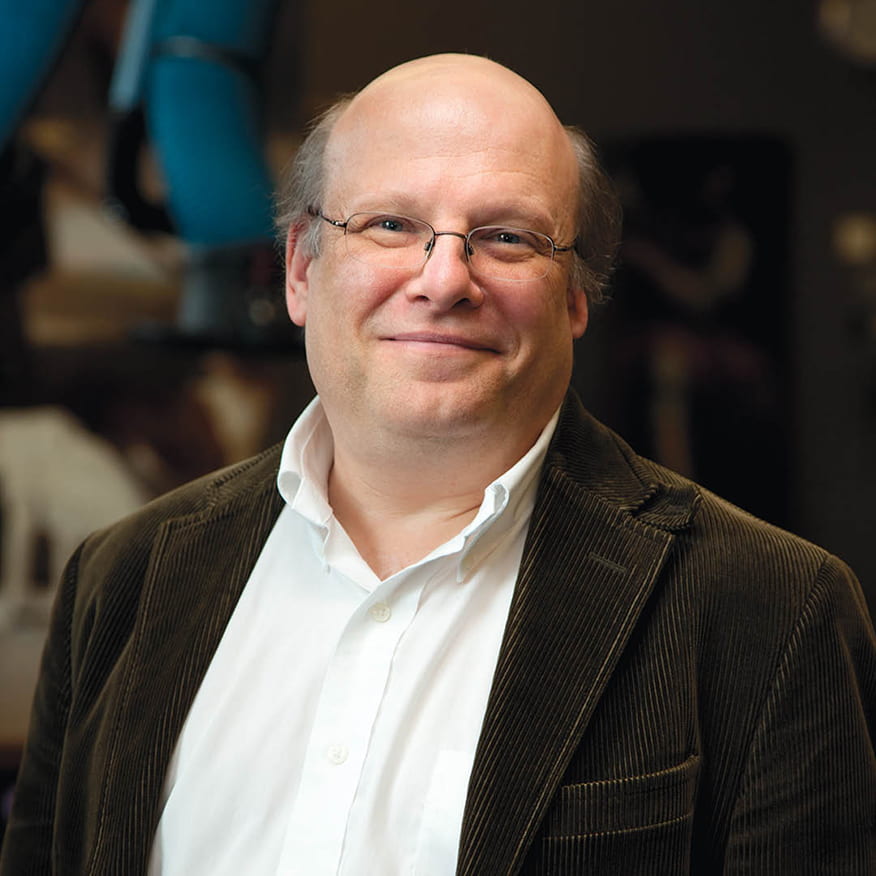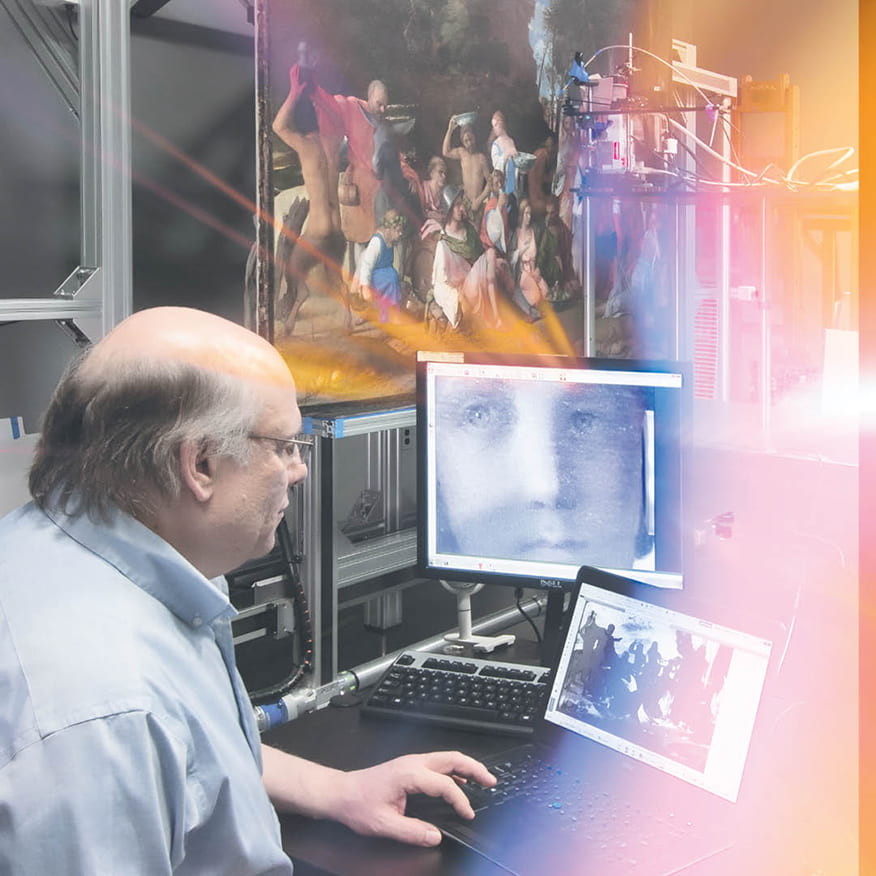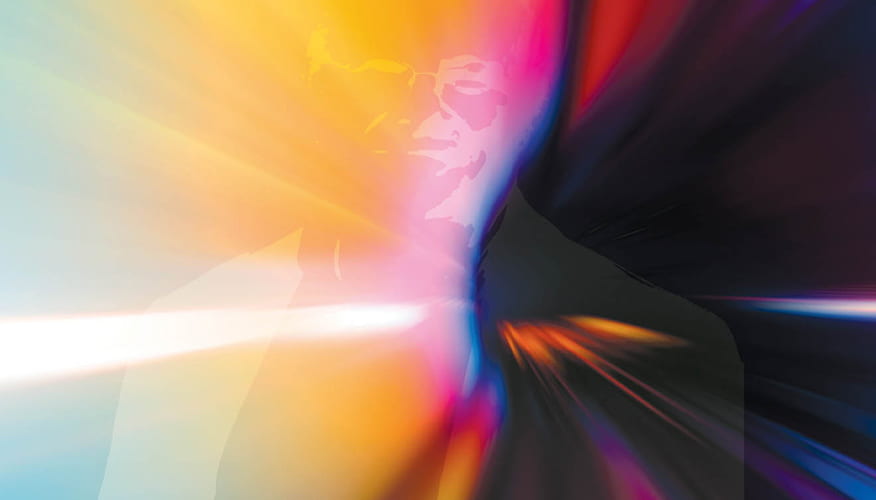Fire Safety as a Human Right
Danielle Antonellis founded a nonprofit to reduce risk in vulnerable communities around the world.
Read StoryJohn Delaney ’84 uses spectral imaging to reveal art’s best-kept secrets.
Through the Zoom screen’s gauzy haze, dark silhouettes can be seen moving along the back wall of a well-lit room. John Delaney ’84 pops into focus, leaning into his webcam for a quick apology. “Sorry, these guys are moving a painting out of here and I’ve got to give them a hand,” he explains before disappearing again into the blurred background. It’s a fitting introduction to a man who has dedicated his entire life to teasing data from what lurks in the shadows.
Trained in optical physics, Delaney has enjoyed a remarkably diverse career. From the study of biomolecules, like in hemoglobin, to the development of electro-optical cameras in the U-2 reconnaissance plane, the WPI alumnus has brought the study of spectral data to a broad range of applications. But it’s the latest chapter in his career that has put him on the map, or perhaps more accurately, in the annals of art history—an unexpected landing for an optical physicist.
Like many great romances, Delaney’s lifelong love affair with light and lenses began in a most unexpected setting—a discount department store in Central Massachusetts. “When I was a kid, I loved astronomy, and this strange store on Route 9 in Shrewsbury called Spag’s had a telescope I very much wanted. Unfortunately, by the time I’d saved up the money to buy it, it was gone,” he recalls. “My parents did the right thing, though, and bought me the next model up.” Inspired by NASA’s Apollo missions and with a new telescope in hand, the young Delaney stoked his nascent love for astronomy and the tools it required.
By high school, Delaney had built his own telescope, and optics itself became an area of scholarly interest. He followed his heart to the WPI campus, where he knocked on the door of physics professor Adriaan Walther. “Here’s a guy very well noted for theoretical geometrical optics, and he invited me in and explained just what they do there and why it was the right place for me,” he says. “At any other school, I’m not sure a man like that would have answered the door, never mind given me so much of his time.” The experience made an impression, and Delaney chose the Worcester school to launch his academic career.

As Walther’s student, Delaney’s interest in optical physics became increasingly sophisticated. “I knew about spectroscopy, but I didn’t know about applications beyond astronomy,” he explains. “WPI introduced me to all these other ways you can use optical spectroscopy, including a lab in which they were studying structural changes in hemoglobin.” While doing research for his Major Qualifying Project, Delaney encountered a paper from a Rockefeller University lab that explored the photosynthetic reaction centers that fuel plant life.
“The researchers at Rockefeller put two molecules together to simulate the light absorption and movement of electrons that start the process of taking light energy and converting it into chemical energy,” he explains. “Their whole idea was to see if this biological process was built on classical electron transfer or quantum mechanical electron tunneling—and I thought that was the coolest thing in the world.”
It was the work’s interdisciplinary nature that piqued Delaney’s interest, and ultimately took him to Rockefeller University as a biophysics graduate student. But beyond providing him a bridge to graduate work, the discovery of Rockefeller’s biomolecular research provided a template for an entire career of cross-disciplinary collaboration.
As if to prove how deep his academic agnosticism went, Delaney’s work took a sharp departure from biophysics once he entered the workforce. He spent nearly a decade designing lenses and optical imaging cameras for the aerospace industry, including an electro-optical camera for the U.S. Air Force’s U-2 reconnaissance plane. In that role, Delaney and his colleagues built high-acuity, multi-spectral cameras designed to capture on-the-ground intelligence from a U-2 flying overhead. His facility with optical systems modeling proved especially useful in this application.
“In school, it’s great if you can get an 85 percent on your engineering exam,” he says, “but the systems we were working with needed to leave the laboratory at the 95-percent level every time. That meant a lot of end-to-end modeling to get those numbers.”
Because of the wide range of skills required for this level of systems modeling, he found himself rubbing shoulders with mathematicians and astronomers just as much as optical and electrical engineers. Delaney’s itch for interdisciplinary collaboration was getting scratched.

However, his day job wasn’t the only place Delaney was applying his skills to interdisciplinary research. Since graduate school, he had kept ties with a friend who worked in the art world and would occasionally call on Delaney’s optical expertise to solve a research conundrum. “At one point, he mentioned that the National Gallery of Art in Washington, D.C., was trying to use an old infrared tube to look at underdrawings in paintings and was having a hell of a time,” he recalls. “I said, ‘Well, for starters, you’ve got the wrong camera.”
Delaney helped the team acquire equipment capable of the infrared and multispectral imaging the museum needed. It became one of many side projects in the years that followed, several of which led to published research papers.
Along the way, Delaney had a critical realization: If organizations like NASA could determine what minerals were present on a planet’s surface using hyperspectral imaging, couldn’t the same technology be used to determine what minerals were present in paint on a canvas? And if it could yield that kind of data, what else could optical engineering reveal about the world’s most treasured works of art? Before long, what had once been an entertaining side project became the next chapter in Delaney’s already diverse career.
To begin to appreciate remarkable art, much can be gleaned by merely looking. Much, but not all. An artist’s choice of composition, color, and brush technique may speak volumes about the final vision—but what about the false starts along the way? Without the benefit of a time machine, how can we peer into an artist’s process, tracing the path of the countless revisions that led to the masterpiece we now know? For that, art turns to science. And the National Gallery of Art turned to John Delaney. After several years of part-time consulting work, the museum offered him the chance to lead its chemical-imaging lab full time in 2007. He jumped at the opportunity to bring applied optics to a field he had only dabbled in thus far.
Since the early 20th century, art historians have used chemical analysis to ascertain the materials and pigments used in the world’s most precious works of art. And though chemical analysis remains the gold standard, the process does have limitations. Microscopic paint chips, about the width of a human hair, must be judiciously extracted from a canvas’s surface, and the subsequent results are largely limited to the area sampled.
Early on, we optimized camera systems to work further in the infrared, showing the drawings underneath the paint layers.
“No one wants you to take a sample from a pristine area of a Vermeer, so you do it lightly and you don’t take too many samples, even if they are microscopic. Also, you have to extrapolate what you’ve learned from the sample to the rest of the painting,” he explained. “Now, there’s quite a lot of interest in non-destructive analysis techniques that use spectroscopic-based measurements.” This, of course, is where Delaney’s area of expertise comes in.
Through the more recent use of reflectance imaging spectroscopy—an approach Delaney had mastered during his time in the aerospace industry—art historians and the scientists who support them are able to virtually peel back the layers of a canvas and reveal the many iterations that led to a final work. They can also use spectroscopic image data to determine what materials an artist used, in much the same way a plane outfitted with a hyperspectral camera can determine the geological make-up of the earth below.
“Early on, we optimized camera systems to work further in the infrared, showing the drawings underneath the paint layers,” says Delaney. “Our newer hyperspectral imaging cameras can also identify materials, so we can say, ‘This blue is from azurite, but this other pigment is lapis lazuli,” an expensive pigment found in Afghanistan. That level of spectral analysis helps art historians determine where a painter has used less expensive materials for a blue sky compared to rarified pigments for the robe of the Virgin Mary, for example.
Early in his work with the National Gallery, Delaney was asked to analyze a Pablo Picasso painting from the artist’s synthetic cubist period. One of the museum’s conservators explained to Delaney that the painting contained just a handful of colors, which would make the spectral analysis “relatively easy.” However, once he had Picasso’s work in the lab, Delaney discovered that what had been assumed to be a single shade of blue actually contained three distinct pigments. “I don’t know that anyone else was terribly excited by that discovery, but it helped me realize, ‘My god, this method is going to work.’”

However, the raw spectral data that came from Delaney’s research proved difficult for some of his art colleagues to interpret, so he and his fellow researchers developed a process to make their findings more visually accessible. With a little help from remote sensing software tools, the team converts the data into a single visual that makes a painting’s many layers interpretable to the casual viewer.
“If that same data was just in a table format or graph, forget about it,” he admits. Like an MRI, the final image shows layers of underpaintings, including preparatory sketches or abandoned works that the artist painted over. In a recent exploration, Delaney and his team discovered numerous compositions hidden beneath a series of Picasso’s Blue Period works. “It may be that the painting wasn’t selling in Paris, so he redid it, creating something that he wanted rather than what someone else suggested he paint.”
As much as Delaney’s research can help bring clarity to a work of art, it can also tease out questions. For years, doubts had swirled around the origins of Girl with a Flute, one of four works in the National Gallery attributed to Dutch master Johannes Vermeer. The painting’s final brushstrokes didn’t match the artist’s typical finesse, suggesting the work may not be a Vermeer at all. The museum’s curators and conservators were itching to dig deeper; however, the work’s popularity made it difficult for Delaney and his colleagues to take the time required for a full investigation. The pandemic gave them the opportunity they needed. As the world shut down, the museum’s research team could bring the National Gallery’s Vermeer paintings into the lab for prolonged periods without annoying museum-goers who had traveled to see works not currently on display.
As Delaney and his colleagues fed round after round of image data to the museum’s curators and conservators, the analysis that came back was shocking. “They explained to us that the handling of the underlayers of paint in Girl with a Flute wasn’t very refined,” he says. “With other works by Vermeer, even the underlayers are more expertly handled than what we were seeing.”
Prompted by their findings on Vermeer’s paintings in the collection, the museum officially changed the painting’s attribution from Vermeer to “studio of Vermeer” in October 2022. But the new distinction sparked its own controversy. Vermeer was not known to have apprentices, so what made the National Gallery’s researchers confident that Vermeer had any relationship whatsoever to Girl with a Flute?
Art takes time to understand, and you really have to look carefully to see what’s going on there.
Though the painting’s technique didn’t rise to that of Vermeer’s other works, the pigments it contained did, adding fuel to a new theory about the master of light. If the materials used in Girl with a Flute matched those of Vermeer’s oeuvre, but the technique did not, it could be that the work had come from his studio but executed by an apprentice. This in itself would be a revelation, suggesting that Vermeer may have mentored other painters. The National Gallery’s findings sparked an ongoing debate among the art community, but one finding remained conclusive: John Delaney had helped bring spectral imaging from the belly of the U-2 recon plane to the back rooms of museums worldwide—and art lovers everywhere had reason to be grateful.
And while Delaney has helped change the world of art research, the experience has also profoundly changed him. Listen long enough and you will hear not so much the language of an optical physicist, but that of an art lover.
An encounter with Jackson Pollock’s 1943 masterpiece Mural illustrates the impact Delaney’s research has had on his relationship with art. Peering beneath the artist’s famous drips and splatters to Mural’s underlayers, Delaney helped confirm a series of painted sketches that belied the abstract expressionist’s seemingly chaotic technique. These sketches below the surface layer showed a series of stick-like human figures across the 19-foot canvas. “It looked like it was moving down a hallway and taking off a jacket. And Pollock built on these figures in the top layer—this was not just slapping down paint,” he explains. “Art takes time to understand, and you really have to look carefully to see what’s going on there.”
As he leans back in his chair, Delaney’s face moves from the shade of the room to full light—a most fitting state for an optical physicist at the peak of his career.